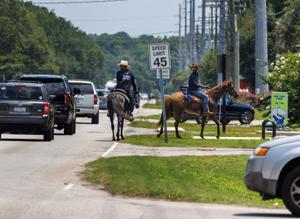
CHARLESTON — The county is continuing efforts to make roads safer using transportation sales tax funds.
While the tax is more widely known for funding larger projects like the flyovers at Main Road and U.S. Highway 17, it also pays for fixing roads at a smaller magnitude by paving dirt and gravel roads, adding turn lanes and constructing sidewalks.
Charleston County has two programs from the transportation sales tax: the annual allocation program funded by the 2004 tax and the rural roads program funded by the 2016 tax.
The annual allocation program pays for bike and pedestrian projects, which includes building sidewalks and multiuse paths; intersection projects, which includes adding or lengthening turn lanes and extending curbs to make pedestrians more visible when crossing the street; and pavement projects, which includes extending roadways and paving gravel roads to help with flooding or drainage issues. The rural roads program money goes toward paving dirt roads.
County Council unanimously approved staff recommendations for which projects from the two road programs should be prioritized for the 2026 fiscal year at a July 17 finance committee meeting. Some of the suggested projects include constructing a sidewalk on N. Nassau Street, conducting a safety audit for Riverland Drive and Woodland Shores Road, and paving several dirt roads on Johns Island.
Alex Owsiak, county capital projects manager, said the county asks municipalities and the state Department of Transportation to send a list of projects can fund from the annual allocation program. Staff then decide which bike and pedestrian, intersection and pavement projects to prioritize based on evaluation criteria, including number of accidents and if the area provides connections to parks or schools, Owsiak said.
The rural roads program provides $2 million in annual funding. Owsiak said county staff look at a list of dirt roads to see which can be paved, judging by the number of residents a road serves and past maintenance costs. The county will be allocating $2.9 million toward the recommended projects for fiscal year 2026, with $900,000 of that funding as carry over from the prior year.
Almost $738,000 has been allocated for bike and pedestrian enhancements, $1.5 million has been set aside for intersection improvement projects and almost $2.6 million is being dedicated to local paving projects. Additional funding has been set aside for each account to offset any increasing costs due to inflation.
Some projects are carried over from the last fiscal year, but are expected to be completed soon, Owsiak said. He added any surplus in funds for those projects will go toward the recommended projects for the upcoming fiscal year.
For requested projects that didn’t make the cut this year, Owsiak said municipalities and DOT can submit the same roads for consideration the following year.
While the projects from the annual allocation program are evenly spread out throughout the county, most of the recommended rural road projects take place in County Councilman Joe Boykin’s district, ranging from Johns Island and Hollywood all the way down to Edisto Island.
Boykin said it’s a big deal for the rural communities to get dirt roads paved. Heavy rain can flood dirt roads and make them impassable, he said.
“I know that people that live on those roads are going to be very happy,” Boykin said. “That’s a game changer.”
(Except for the headline, this story has not been edited by PostX News and is published from a syndicated feed.)

